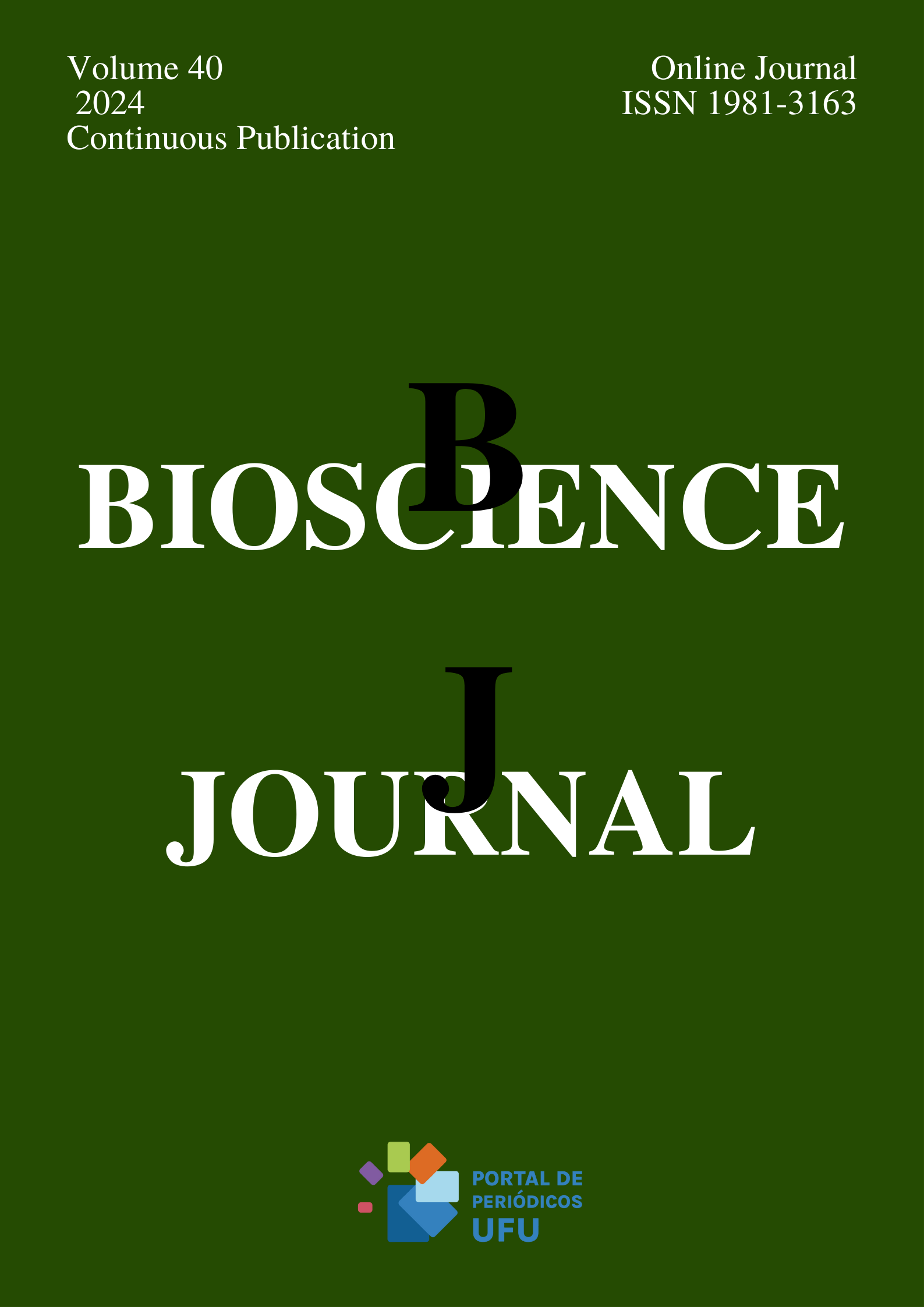Increased resistance rates of extended-spectrum β-lactamase-producing Enterobacterales isolated from blood cultures in Brazil
DOI:
https://doi.org/10.14393/BJ-v40n0a2024-69495Keywords:
Beta-lactamases, Blood culture, Drug resistanceAbstract
This study aimed to identify and evaluate the antimicrobial susceptibility profile of extended-spectrum β-lactamase (ESBL)-producing Enterobacterales isolated from blood cultures of patients with suspected sepsis. This retrospective cross-sectional epidemiological study was performed for four years (2015 to 2018) by accessing the medical records of patients diagnosed with bloodstream infections in two tertiary public hospitals in Brazil. Culture results and susceptibility tests of bacterial strains isolated from blood samples were analyzed. During four years, 2,263 blood culture exams were performed, and Enterobacterales were isolated in 694 (30.7%) samples. The disk approximation test detected ESBL production in 171 (24.6%) of the 694 isolated Enterobacterales (p<0.05), with 125 (73.1%) corresponding to Klebsiella spp., 28 (16.2%) to Escherichia coli, eight (4.6%) to Enterobacter spp., five (2.9%) to Serratia spp., three (1.7%) to Proteus spp., and two (1.2%) to Citrobacter spp. All tested antibiotics demonstrated low susceptibility (2.9% to 26.9%). The classes of monobactams, cephalosporins, and penicillin showed high resistance indices. The evaluated Enterobacterales isolates exhibited expressive antimicrobial resistance to drugs commonly used as empirical treatment in bloodstream infections. The findings reinforce the relevance of assessing the bacterial antimicrobial susceptibility profile, as it drives antibiotic therapy, potentially detecting multiresistance cases.
References
ADEOLU, M., et al. Genome-based phylogeny and taxonomy of the 'Enterobacteriales': proposal for Enterobacterales ord. nov. divided into the families Enterobacteriaceae, Erwiniaceae fam. nov., Pectobacteriaceae fam. nov., Yersiniaceae fam. nov., Hafniaceae fam. nov., Morganellaceae fam. nov., and Budviciaceae fam. nov. International Journal of Systematic and Evolutionary Microbiology. 2016, 66(12), 5575-5599. https://doi.org/10.1099/ijsem.0.001485
BAKER, T.M., et al. Epidemiology of Bloodstream Infections Caused by Escherichia coli and Klebsiella pneumoniae That Are Piperacillin-Tazobactam-Nonsusceptible but Ceftriaxone-Susceptible. Open Forum Infectious Diseases. 2018, 5(12), 1-7. https://doi.org/10.1093/ofid/ofy300
CARVALHO, I., et al. Multidrug-resistant Klebsiella pneumoniae harboring extended spectrum β-lactamase encoding genes isolated from human septicemias. PLoS One. 2021, 16(5), e0250525. https://doi.org/10.1371/journal.pone.0250525
CHOPRA, T., et al. Risk factors for bloodstream infection caused by extended-spectrum β-lactamase-producing Escherichia coli and Klebsiella pneumoniae: a focus on antimicrobials including cefepime. American Journal of Infection Control. 2015, 43(7), 719-723. https://doi.org/10.1016/j.ajic.2015.02.030
DE LASTOURS, V., et al. Mortality in Escherichia coli bloodstream infections: antibiotic resistance still does not make it. Journal of Antimicrobial Chemotherapy. 2020, 75(8), 2334–2343. https://doi.org/10.1093/jac/dkaa161
DIRAR, M.H., et al. Prevalence of extended-spectrum β-lactamase (ESBL) and molecular detection of blaTEM, blaSHV and blaCTX-M genotypes among Enterobacteriaceae isolates from patients in Khartoum, Sudan. Pan African Medical Journal. 2020, 37(213), 1-11. https://doi.org/10.11604/pamj.2020.37.213.24988
GAIBANI, P., et al. Bloodstream infection caused by KPC-producing Klebsiella pneumoniae resistant to ceftazidime/avibactam: epidemiology and genomic characterization. Clinical Microbiology and Infection. 2020, 26(4): 516.e1-516.e4. https://doi.org/10.1016/j.cmi.2019.11.011
KABI, A., et al. Clinical spectrum and risk factors for hospital-acquired septicemia in a tertiary care centre of North-East India. Journal of Family Medicine and Primary Care. 2020, 9(8): 3949-3954. https://doi.org/10.4103/jfmpc.jfmpc_469_20
LEPE, J.A. and MARTÍNEZ-MARTÍNEZ, L. Resistance mechanisms in Gram-negative bacteria. Medicina Intensiva (English Edition). 2022, 46(7): 392-402. http://doi.org/10.1016/j.medine.2022.05.004
LING, W., et al. Adverse clinical outcomes associated with infections by Enterobacterales producing ESBL (ESBL-E): a systematic review and meta-analysis. JAC-Antimicrobial Resistance. 2021, 3(2), 1-11. https://doi.org/10.1093/jacamr/dlab068
MISHRA, S.K., et al. Extended-spectrum beta-lactamase and metallo-beta-lactamase-producing bacterial strains among the patients attending a tertiary care center in Nepal. International Journal of Infectious Diseases. 2012, 16S, e317–e473. https://doi.org/10.1016/j.ijid.2012.05.592
NIVESVIVAT, T., et al. Clinical epidemiology, risk factors and treatment outcomes of extended-spectrum beta-lactamase producing Enterobacteriaceae bacteremia among children in a Tertiary Care Hospital, Bangkok, Thailand. BMC Research Notes. 2018, 11(1), 1-5. https://doi.org/10.1186/s13104-018-3729-3
PEIRANO, G. and PITOUT, J.D.D. Extended-Spectrum β-Lactamase-Producing Enterobacteriaceae: Update on Molecular Epidemiology and Treatment Options. Drugs. 2019, 79, 1529–1541. https://doi.org/10.1007/s40265-019-01180-3
RAWAT, D. and NAIR, D. Extended-spectrum ß-lactamases in gram negative bacteria. Journal of Global Infectious Diseases. 2010, 2(3), 263–274. https://doi.org/10.4103/0974-777X.68531
RIOS-NETO, M.A., et al. High rates of antimicrobial resistance of ESBL-producing Enterobacteriaceae isolated from clinical samples in Northeast of Brazil. Infectious Diseases. 2017, 50(3), 229-231. https://doi.org/10.1080/23744235.2017.1381987
ROCHA, F.R., et al. High Frequency of Extended-Spectrum Beta-Lactamase-Producing Klebsiella pneumoniae Nosocomial Strains Isolated from a Teaching Hospital in Brazil. Microbial Drug Resistance. 2019, 25(6), 909-914. https://doi.org/10.1089/mdr.2018.0142
ROTTIER, W.C., AMMERLAAN, H.S.M. and BONTEN, M.J.M. Effects of confounders and inter- mediates on the association of bacteraemia caused by extended-spectrum b-lactamase-producing Enterobacteriaceae and patient outcome: a meta- analysis. Journal of Antimicrobial Chemotherapy. 2012, 67(6), 1311–1320. https://doi.org/10.1093/jac/dks065
RUGINI, C.L., SOBOTTKA, A.M. and FUENTEFRIA, D.B., Occurrence and sensitivity profile of extended spectrum beta-lactamase-producing Enterobacteriaceae at a tertiary hospital in Southern Brazil. Revista da Sociedade Brasileira de Medicina Tropical, 2015, 48(6), 692-698. https://doi.org/10.1590/0037-8682-0211-2015
SANGARE, A.S., et al. Prevalence of ESBL-producing Enterobacteriaceae isolated from blood cultures in Mali. The Journal of Infection in Developing Countries. 2016, 10(10), 1059-1064. https://doi.org/10.3855/jidc.7536
SCHEUERMAN, O., et al. Comparison of Predictors and Mortality Between Bloodstream Infections Caused by ESBL-Producing Escherichia coli and ESBL-Producing Klebsiella pneumoniae. Infection Control & Hospital Epidemiology. 2018, 39(6), 660–667. https://doi.org/10.1017/ice.2018.63
SHAMSRIZI, P., et al. Variation of effect estimates in the analysis of mortality and length of hospital stay in patients with infections caused by bacteria-producing extended-spectrum beta-lactamases: a systematic review and meta-analysis. BMJ Open. 2020, 10(1), 1-10. http://dx.doi.org/10.1136/bmjopen-2019-030266
Downloads
Published
Issue
Section
License
Copyright (c) 2024 Raí Emanuel da Silva, Nathanael dos Santos Alves, Cynthia Karolina Rodrigues do Nascimento, Raylane Meneses Marques dos Santos, Wellerson Lucas de Pinho Barreto, Jadiel Silva Reis Filho, Victor Brito Dantas Brito Dantas Martins, Erika Cecília Vallim Severino, Marcelo Costa Araújo, Miguel Araújo Rios Neto, Aline Dias Paiva, Kennio Ferreira-Paim, Fernanda Machado Fonseca

This work is licensed under a Creative Commons Attribution 4.0 International License.





